 W
WThe Pentatomoidea are a superfamily of insects in the Heteroptera suborder of the Hemiptera order. As Hemiptera, they share a common arrangement of sucking mouthparts. The roughly 7000 species under Pentatomoidea are divided into 21 families. Among these are the shield bugs, giant shield bugs, burrower bugs, and stink bugs.
 W
WBanasa dimidiata, the green burgundy stink bug, is a species of stink bug in the family Pentatomidae. It is found in North America.
 W
WBrachyplatys is a genus of shield bugs belonging to the family Plataspidae.
 W
WBrachyplatys punctipes is a species of shield bugs belonging to the family Plataspidae found in China.
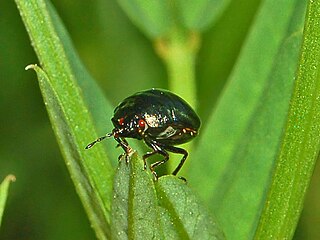 W
WCoptosoma is a genus of true bugs belonging to the family Plataspidae, subfamily Platasdinae.
 W
WCoptosoma elegans is a species of true bugs belonging to the family Plataspidae, subfamily Plataspinae.
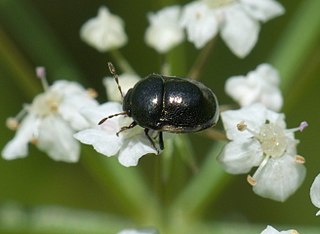 W
WCorimelaena is a genus of ebony bugs in the family Thyreocoridae. There are at least 20 described species in Corimelaena.
 W
WCorimelaena incognita is a species of ebony bug in the family Thyreocoridae. It is found in Central America and North America.
 W
WCorimelaena pulicaria, the black bug, is a species of ebony bug in the family Thyreocoridae. It is found in Central America and North America.
 W
WThe Corimelaeninae are a subfamily of shield bugs within the family Thyreocoridae. It has often been treated as a family (e.g.), but the name Thyreocoridae, published in 1843, has nomenclatural priority over Corimelaenidae, published in 1872.
 W
WThe Dinidoridae are a small family of insects comprising about a hundred species in sixteen genera in the Hemipteran suborder Heteroptera, the "true bugs". As a group the family does not have any common name. Until the late 19th century they were generally regarded as a subfamily of the Pentatomidae.
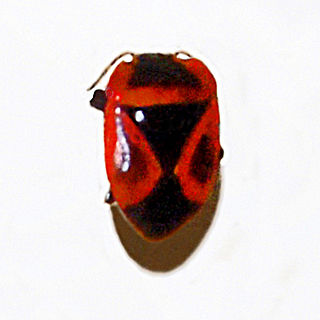 W
WDismegistus costalis is a species of true bugs belonging to the family Parastrachiidae.
 W
WErthesina is a genus of stink bugs in the family Pentatomidae. There are at least two described species in Erthesina.
 W
WErthesina fullo, commonly known as the yellow-spotted stink bug or yellow marmorated stink bug, is a species of stink bug in the family Pentatomidae. It is found in east and southeast Asia. It is one of the most widely distributed phytophagous insect pests in Asia, and feeds on dozens of host plants including a number of economically important fruits, such as apples, cherries, pears, and kiwifruit.
 W
WMegacopta is a genus of true bugs in the family Plataspidae.
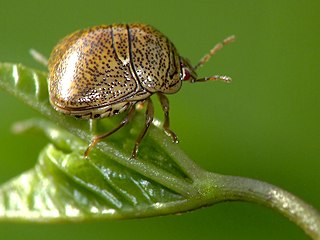 W
WMegacopta cribraria, also called the bean plataspid, kudzu bug, globular stink bug and lablab bug, is a shield bug native to India and China, where it is an agricultural pest of lablab beans and other legumes. The bug, while harmless to houseplants and people, often enters houses. It is attracted to white surfaces such as the walls of houses or white vehicles, because of the high reflectance of the white surfaces as it relates to the bugs' simple eyes. As a defense mechanism, they emit a foul-smelling pheromone that also acts as a congregation pheromone. Aside from smelling foul, the liquid also creates a burning sensation and sometimes leaves a red welt on bare skin. It is similar to other Plataspididae in having a somewhat unusual symbiotic relationship with its gut bacteria. Before laying eggs, females deposit particles containing the symbiont, which are then eaten by newly hatched nymphs under natural conditions. Nymphs experimentally deprived of access to the symbiont exhibited slower growth, smaller body sizes and higher mortality.
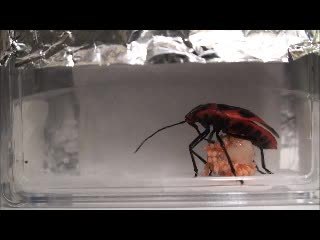 W
WParastrachia japonensis is a species of true bugs belonging to the family Parastrachiidae. It is one of the two species in the genus, both from Eastern Asia.
 W
WParastrachiidae is a family of true bugs belonging to the ordo Hemiptera. It had been considered to be a subfamily under family Cydnidae, but it was raised to family status in 2002.
 W
WPentatomidae is a family of insects belonging to the order Hemiptera, generally called shield bugs or stink bugs. Pentatomidae is the largest family in the superfamily Pentatomoidea, and contains around 900 genera and over 4700 species. As hemipterans, the pentatomids have piercing sucking mouthparts, and most are phytophagous, including several species which are severe pests on agricultural crops. However, some species, particularly in the subfamily Asopinae, are predatory and may be considered beneficial.
 W
WPlataspidae are a family of shield bugs native to the Old World. One species, Megacopta cribraria, has recently become introduced and established in the southeastern United States, where it is a pest of soybeans.
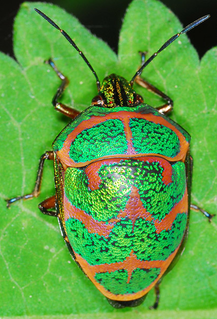 W
WPoecilocoris is a genus of shield-backed bugs in the family Scutelleridae. There are more than 20 described species in Poecilocoris, found mainly in south and east Asia, including Indomalaya.
 W
WScutelleridae is a family of true bugs. They are commonly known as jewel bugs or metallic shield bugs due to their often brilliant coloration. They are also known as shield-backed bugs due to the enlargement of the thoracic scutellum into a continuous shield over the abdomen and wings. This latter characteristic distinguishes them from most other families within Heteroptera, and may lead to misidentification as a beetle rather than a bug. These insects feed on plant juices from a variety of different species, including some commercial crops. Closely related to stink bugs, they may also produce an offensive odour when disturbed. There are around 450 species worldwide.
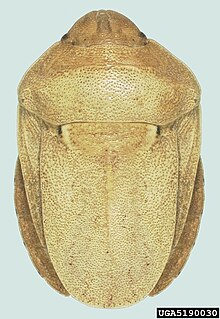 W
WA sunn pest is an insect belonging to a group representing several genera of the 'shield bug' (Scutelleridae) and 'stink bug' (Pentatomidae) Families, with the species Eurygaster integriceps being the most economically important. Sunn pests are found in parts of North Africa, throughout West Asia and many of the new independent states of Central Asia.
 W
WThyreocoris is a genus of shield bug belonging to the family Thyreocoridae.
 W
WThyreocoris scarabaeoides is a species of shield bug found in Europe. It is small (3–4 mm.), nearly round and dark bronzy coloured. The surface is shining, glabrous and strongly punctured. The antennae are piceous, the scutellum not quite covering the corium and membrane. The legs are black with spinose tibiae and piceous tarsi.
 W
WUrostylididae is a family of true bugs and is considered a basal or "primitive" family within the stink-bug lineage. They are found only in Asia. Older works used the spelling Urostylidae but this clashes with the name used for a protozoan family and a spelling correction (emendation) has been suggested that also avoids the confusion created by homonyms. The family name Urolabididae has also been used for some members in the past.